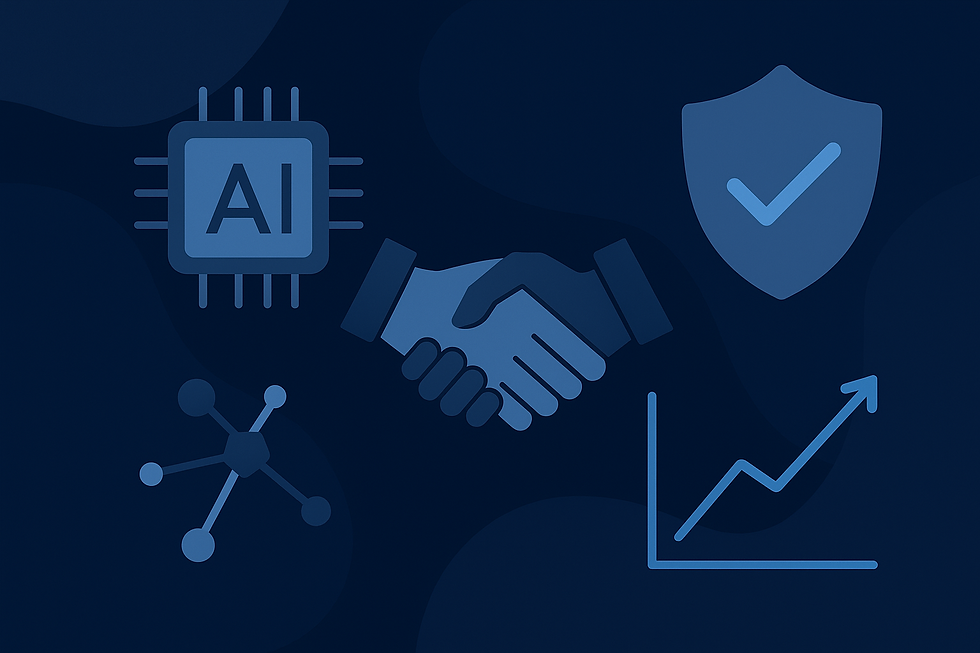Why Responsible AI is Your Competitive Edge. Not Just a Compliance Burden.
- jvourganas

- Jun 13
- 3 min read

Abstract
Artificial Intelligence is no longer a siloed innovation initiative, it’s a board-level agenda item. As AI capabilities mature, so do the expectations surrounding their ethical deployment. The prevailing narrative that responsible AI is primarily a compliance overhead is not only antiquated, it’s commercially dangerous. For CTOs, founders, and executive leaders, integrating responsible AI is a matter of strategic foresight. This article reframes ethical AI as a business enabler, offering a roadmap to competitive resilience, investor confidence, and long-term enterprise value.
Introduction: Responsible AI Enters the C-Suite
The old model, build first, regulate later, is collapsing. In its place is a more resilient thesis: that ethical design is not orthogonal to innovation, but foundational to it. Regulatory landscapes like the EU AI Act, the U.S. Algorithmic Accountability Act, and global ESG frameworks are no longer fringe signals, they’re front-and-center boardroom mandates.
Decision-makers no longer ask if responsible AI matters. The question is how fast, how credibly, and how scalably you can integrate it.
The Strategic Leverage of Responsible AI
Trust as Strategic Infrastructure
Ethical design choices today become durable reputation assets tomorrow. AI transparency and fairness are increasingly treated as preconditions in B2B procurement, particularly among enterprise clients and public-sector partners.
In a saturated market, trust isn’t a soft metric, it’s your conversion rate. Responsible AI earns you not just users, but advocates.
Investor Differentiation
VC and LP portfolios are under ESG scrutiny. Startups that operationalize responsible AI, through traceability, fairness benchmarks, or documentation maturity, signal capital-efficient governance. Ethical infrastructure is fast becoming a due diligence differentiator.
Mature AI governance can lead to smoother funding cycles, reduced legal contingencies during due diligence, and stronger exit multiples.
Risk-Informed Innovation
Bias isn’t just an ethical risk, it’s a product risk. Unchecked bias propagates error rates across subpopulations, increasing legal exposure, undermining performance in edge cases, and complicating retraining cycles. Ethical AI reduces entropy in model behavior.
Moreover, explainability improves debuggability, enabling faster iteration and model improvement cycles.
Strategic Optionality in Global Markets
Companies that pre-emptively align with regulatory gold standards unlock smoother entry into regulated jurisdictions. Ethical readiness translates into faster market penetration and greater strategic optionality.
This optionality isn't theoretical, it affects real go-to-market timelines, international procurement access, and cross-border licensing.
Case Insight: Responsible AI as Strategic Readiness
Consider a healthtech startup leveraging deep learning to triage patient symptoms. By integrating fairness metrics and model interpretability from its alpha stage, it avoided months of compliance retrofitting when entering EU markets. More than that, it positioned itself as a preferred vendor for hospitals prioritizing algorithmic transparency.
Another example: a fintech firm built its fraud detection AI with embedded audit logs, stakeholder-accessible model cards, and fairness metrics across demographics. When approached for acquisition, it demonstrated lower AI risk exposure, accelerating due diligence and raising valuation.
CTO Imperatives: How to Embed Ethical Advantage
Shift from Retrospective to Embedded Ethics: Operationalize responsibility at the infrastructure layer—data pipelines, model training protocols, evaluation metrics.
Codify Model Governance: Introduce versioned model cards, reproducibility logs, and audit flags as default artifacts in your MLOps workflow.
Build Techno-Legal Symbiosis: Form governance pods that include legal, product, ML engineering, and UX—a cross-functional architecture for anticipatory compliance.
Monitor Fairness Like You Monitor Latency: Integrate fairness drift detection into your observability stack. Model integrity is a runtime variable, not just a training concern.
Automate Governance Where Possible: Build rule-based compliance triggers into your CI/CD pipeline to ensure reproducibility and standards alignment.
Executive Talking Points for the Board
“Responsible AI reduces long-term risk while enabling market access in regulated regions.”
“Our governance posture is now part of our pitch deck, because it matters to our partners and capital sources.”
“We want to be the brand that gets called into the room, not regulated out of it.”
“Ethics scales trust. Trust scales revenue.”
Overall: Build Intelligently, Lead Relentlessly
The new wave of AI leadership belongs to companies that understand a simple principle: in a world demanding explainability, accountability, and inclusion, responsible AI isn’t friction, it’s strategy.
It is cheaper to build trust than to buy back reputation. The smartest CTOs are not asking if to adopt responsible AI, they are operationalizing it before their competitors even catch on.
Responsible AI isn’t a “nice to have.” It’s your precondition for growth, partnership, and survival in the next generation of intelligent systems.
Don’t just be AI-powered. Be AI-principled, and future-fit.




Comments